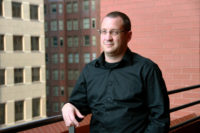Architect Profile: Amy Nicole Swift
Each month W&C interviews a new architect to hear their perspective.






 Amy Nicole Swift, LEED-AP, is an architect, writer, and artist living-working-advocating in the city of Detroit. In 2012, she formed Building Hugger to fill what she saw as a void in accessible renovation design focused on marginalized vernacular structures. She has taught adaptive architectural design at the University of Detroit Mercy, and currently lectures on the history and theory of 20th century architecture at Lawrence Technological University.
Amy Nicole Swift, LEED-AP, is an architect, writer, and artist living-working-advocating in the city of Detroit. In 2012, she formed Building Hugger to fill what she saw as a void in accessible renovation design focused on marginalized vernacular structures. She has taught adaptive architectural design at the University of Detroit Mercy, and currently lectures on the history and theory of 20th century architecture at Lawrence Technological University.
W&C Architect: How many years do you have in the profession?
Swift: Seven years
W&C Architect: What is your work history in this field?
Swift: I spent five years working for a large international corporate architectural firm out of their Chicago, New York and San Francisco offices before returning to my native Detroit to start my own design firm. I am also currently an adjunct professor of architectural design, history and theory at Lawrence Technological University.
W&C Architect: Where did you go to school?
Swift: I studied architecture at Kent State but finished my BS in Interior Architecture at Lawrence Technological University. After three years of practice I returned to get my MS in Historic Preservation from Columbia University in NYC.
W&C Architect: Did you have a specialization?
Swift: My focus has always been on materials—the processes by which they are available to us, their phenomenological qualities, the tectonics of their construction, the cultural implications of their availability, how they age or need repair, what they become at the end of their useful life. It’s like sustainability, design theory, construction practices, historic preservation and cultural anthropology all rolled into one tangible worldview.
W&C Architect: Do you approach architecture from an artistic or functional starting point? Are the two concepts exclusive?
Swift: This is one of the questions I pose to my history/theory students quite often. Personally, I believe all good design is mutually inclusive of these ideas. To help illustrate this in the classroom I ask, “Who would you rather go on a date with? Someone who is aesthetically pleasing, someone that fills the basic needs of companionship, or both?” Obviously you’d want both if you could find it. This is true of architecture, and it is often just as difficult to find.
W&C Architect: If any, who are your role models?
Swift: Beatriz Colomina. The research she has contributed to women’s studies in architectural history and theory has been fundamental to my perspective of the field and my role as a woman in what is still largely a man’s profession.
W&C Architect: What projects, other than your own work, do you find inspiring?
Swift: I find the bootstrap kind of revitalization projects here in Detroit incredibly inspiring. Often the resources aren’t available for heavy-handed design by a contracted architect, so it’s the community that pitches in to help build and create spaces that work for them. Examples of these are Ponyride, Lincoln Street Art Park, the storefronts of Revolve Detroit, and a million others.
W&C Architect: How many buildings have you designed?
Swift: True to this age of architectural specialization I have not carried a project solo from start to finish. I have instead been a part of a team on dozens of projects, holding various roles in all stages of design and construction. Now that I practice on my own I take ownership of more stages of the design process, but I am generally working on renovations to existing structures. I guess I’m not interested in the quantity, but the quality.
W&C Architect: If you had to choose one to represent your work, what project would you choose?
Swift: Last fall I purchased a development property in the Wayne County tax auction for a song. This project is an experiment to explore new roles as not only designer, but also of owner, contractor, laborer and ultimately property management. I wanted to understand better what many of my clients go through as owners of vacant or underutilized property in Detroit, so I jumped in the hotseat myself.
W&C Architect: What are your guiding principles when designing a structure?
Swift: I practice in the realm of salvage, reuse, adaptation and preservation. In order to determine what to do with an existing building or material, I first spend time with it. Generally, I think everything can have a second, third and even infinite life if we are open to the creative possibilities embedded in materials.
W&C Architect: If you could have any building to redesign—anywhere in the world—which would you like to address?
Swift: Every building is an archive of the cultural, architectural, political, financial and technological forces that willed it into being, for better or for worse. Who am I to change any of this for my own personal interest?
W&C Architect: What types of products interest you?
Swift: At the moment I’m mostly working on small-scale residential design, so products related to that. I’m environmentally savvy with my specifications, which sometimes means there’s a product solution and sometimes means there’s a design solution.
W&C Architect: What types of products in the wall and ceiling industry really interest you?
Swift: Any product that can help me patch, repair, and preserve historic structures and bring them up to modern codes without being nasty to the environment or my health.
Looking for a reprint of this article?
From high-res PDFs to custom plaques, order your copy today!







